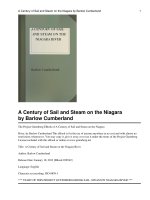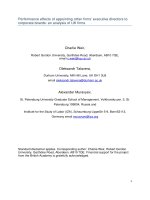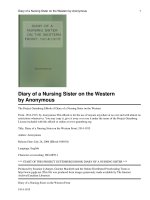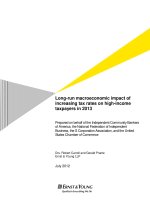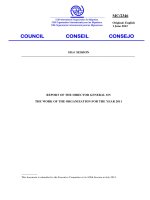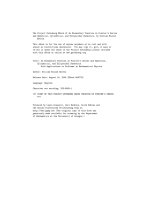Performance improvement of tio2 catalysts supported on adsorbents
Bạn đang xem bản rút gọn của tài liệu. Xem và tải ngay bản đầy đủ của tài liệu tại đây (4.46 MB, 212 trang )
PERFORMANCE IMPROVEMENT OF TiO
2
CATALYSTS
SUPPORTED ON ADSORBENTS
LI GANG
NATIONAL UNIVERSITY OF SINGAPORE
2007
PERFORMANCE IMPROVEMENT OF TiO
2
CATALYSTS
SUPPORTED ON ADSORBENTS
LI GANG
(PhD, NUS)
A THESIS SUBMITTED
FOR THE DEGREE OF PhD OF ENGINEERING
DEPARTMENT OF CHEMICAL AND BIOMOLECULAR ENGINEERING
NATIONAL UNIVERSITY OF SINGAPORE
2007
Acknowledgement
Acknowledgement
I would like to convey my deepest appreciation to my supervisor, Assoc. Prof. Zhao
X. S., George for his constant encouragement, invaluable guidance, patience and
understanding throughout the whole length of my PhD candidature. This project had
been a tough but enriching experience for me in research. I would like to express my
heartfelt thanks to A/P Dr. Zhao for his guidance on writing scientific papers including
PhD thesis.
I would also like to take this opportunity to acknowledge Prof. M. B. Ray for her
kindly advice and guidance during first 2 years of my research work. In addition, I
want to express my sincerest appreciation to the Department of Chemical and
Biomolecular Engineering for offering me the chance to study at NUS with a
scholarship.
It’s my pleasure to work with a group of brilliant, warmhearted and lovely people,
Dr. Zhou Zuocheng, Dr. Su Fabing, Dr. Lv Lu, Dr. Yan Qingfeng, Dr. Zhou Jinkai,
Mr. Bao Xiaoying, Mr. Wang Likui, Mr. Bai Peng, Ms. Lee Fang Yin, Ms. Liu Jiajia,
Ms. Tian Xiaoning, Ms. Zhang Lili, Ms. Wu Pingping.
Particular acknowledgement goes to Mr. Chia Phai Ann, Mr. Shang Zhenhua, Dr.
Yuan Zeliang, Mr. Mao Ning, Dr. Rajarathnam D., Madam Chow Pek Jaslyn, Mdm
Fam Hwee Koong Samantha, Ms Lee Chai Keng, Ms Tay Choon Yen, Mr. Toh Keng
Chee, Mr. Chun See Chong, Ms. Goh Siew Ping, Ms. Ng Ai Mei, Ms. Lum Mei Peng
Sharon, and Ms. How Yoke Leng Doris for their kind supports.
I thank my wife, Mo Huajuan, my daughter, parents, and brother. It is no
exaggeration to say that I could not complete the PhD work without their generous
help, boundless love, encouragement and support.
i
Table of Contents
Table of Contents
Summary………………………….………………………………………………… vii
Nomenclature ………………………………………………………………… ix
List of Tables …….…………………………………………………………… xi
List of Figures………………………………………………………….………… xii
CHAPTER 1 INTRODUCTION………………………… ……….……….…1
1.1 Background… 1
1.2 Application of photocatalyst TiO
2
in wastewater treatment…………… 3
1.3 Objectives of the project………………………………………….………….9
1.4 Structure of thesis…… ……………………………………………………10
CHAPTER 2 LITERATURE REVIEW………………….…… ……….….12
2.1 Principles of semiconductor photocatalysis 12
2.1.1 Radiation source … 12
2.1.2 Mechanism of TiO
2
photocatalyst………………………….… ……….15
2.1.3 TiO
2
surface reactions…………………………………….………… 19
2.1.4 Role of OH
•
radicals……….………………….……….……………… 21
2.1.5 Kinetics of TiO
2
photocatalysis………….………….…………………22
2.2 Particle dispersion of TiO
2
……………………………………………… 24
2.2.1 Heterogeneous photocatalysis………………………….………… … 24
2.2.2 Particle aggregation……………………….………………….…….… 26
2.2.3 Methods for avoiding/minimizing particle aggregation … 28
2.3 Roles of support …………………….……………………………… ….…31
2.3.1 TiO
2
supported on porous materials……………………………… 32
2.3.2 TiO
2
supported on non-porous materials…….………….…….… …41
ii
Table of Contents
2.3.3 Adsorbents used as a TiO
2
support………………………………… 47
2.3.3.1 β-zeolite… 47
2.3.3.2 Al-pillared Montmorillonite……………….………………… 48
2.3.3.3 MCM-41 … 49
2.3.3.4 SBA-15……………………………………………….………….50
2.4 pH effect on photoreaction……………………………………………….….51
2.5 Enhancement of photocatalytic reaction rate… ………….….……………54
2.5.1 Hydrogen peroxide…………………………….………………………55
2.5.2 Ozone………………………………………………………………….60
2.5.3 Noble metal doping……………………………………………………62
2.6 Catalyst reuse………………………………………………….…………….66
2.6.1 Sedimentation separation……………………….…………………… 67
2.6.2 Magnetic separation……………………………………….………… 69
CHAPTER 3 EXPERIMENTAL SECTION………………………………72
3.1 Reagents and apparatus……………………………………….………… 72
3.2 Synthesis of supported TiO
2
photocatalysts……………… …….…….…74
3.2.1 Synthesis of MCM-41……………………………………….…… …74
3.2.2 Synthesis of supported TiO
2
photocatalyst by sol-gel method… …75
3.2.3 Synthesis of Ti-SBA-15 by co-precipitation method
75
3.2.4 Synthesis of Ti-SBA-15 by impregnation method……………….……76
3.2.5 Synthesis of silica microspheres………………….……………………76
3.2.6 Synthesis of SiO
2
/TiO
2
core/shell photocatalysts…………………… 77
3.2.7 Synthesis of SiO
2
/TiO
2
-Pt photocatalysts…………………… ………78
3.2.8 Synthesis of TiO
2
fiber……………………………………….……… 78
3.3 Characterization ……………………………………………….………… 79
iii
Table of Contents
3.3.1 Scanning electron microscopy (SEM) ………………………………79
3.3.2 Energy dispersive X-ray spectrometry (EDX) 79
3.3.3 Diffusive reflectance UV-Vis spectrophotometer (DR-UV)…….….…80
3.3.4 N
2
adsorption/desorption……………………………….….……… …80
3.3.5 Magic-angle spinning-nuclear magnetic resonance (MAS-NMR)
spectroscopy………………………………………………………………….81
3.3.6 X-ray diffraction (XRD)…………………………….…………………81
3.3.7 X-ray photoelectron spectroscopy (XPS)…………….……………… 82
3.3.8 Zeta potential……………………………………….………………….82
3.3.9 Transmission electron microscopy (TEM)……………….……………83
3.4 Evaluation of photocatalytic activity………………….……………….… 83
CHAPTER 4 REDISPERSION OF TiO
2
NANOPARTICLES IN
AQUEOUS PHASE BY VARYING SOLUTION pH AND SURFACE
MODIFICATION WITH POLYELECTROLYTE
………………….… 86
4.1 Introduction………………………………….………….……….……………86
4.2 Results and discussion……………………….…….………………… ……88
4.2.1 Effect of catalyst dosage on its photoactivity……
…………… ……88
4.2.2 Redispersion of TiO
2
nanoparticles in aqueous phase by varying
solution pH……………
……………………………………………………….92
4.2.3 Redispersion of TiO
2
nanoparticles in aqueous phase by surface
modification with polyelectrolyte…………….………….… ……………… 98
4.3 Summary…………………………….…………………… ………… ……103
iv
Table of Contents
CHAPTER 5 ADVANCED OXIDATION OF ORANGE II USING
TiO
2
SUPPORTED ON POROUS ADSORBENTS: THE ROLE OF
pH, H
2
O
2
AND O
3
………………………………………………….… 104
5.1 Introduction…………………………… ………………………….…….….104
5.2 Results and discussion………………………………………….….…… 105
5.2.1 Characterization of the catalysts …………………….……… …….105
5.2.2 Dark adsorption of orange II ………………………………… … 109
5.2.3 Photocatalytic degradation of orange II…….………………… ….112
5.2.4 Total organic carbon (TOC) degradation ……………………… 114
5.3 Summary… 120
CHAPTER 6 CHARACTERIZATION AND PHOTOCATALYTIC
PROPERTIES OF TITANIUM-CONTAINING MESOPOROUS
SBA-15
……………………………………………….….………………………….121
6.1 Introduction………………………………………….……………… …121
6.2 Results and discussion……
…………………………………………… 124
6.2.1 Characterization of photocatalysts ……………………………….…124
6.2.2 Photocatalytic properties of titanium-containing SBA-15.……
…… 137
6.3 Summary…………………………………………………….…………… 142
CHAPTER 7 PREPARATION AND CHARACTERIZATION OF
SiO
2
/TiO
2
-Pt CORE/SHELL NANOSTRUCTURES AND
EVALUATION OF THEIR PHOTOCATALYTIC ACTIVITY
… 143
7.1 Introduction…………………………….………………………….……… 143
7.2 Results and discussion……………………….…
………………………… 145
7.2.1 Characterization of the SiO
2
/TiO
2
core/shell photocatalysts …… 145
v
Table of Contents
vi
7.2.2 Photocatalytic activity of the SiO
2
/TiO
2
core/shell photocatalysts… 152
7.2.3 Reuse of the SiO
2
/TiO
2
core/shell photocatalysts….……….……… 153
7.2.4 Characterization of the SiO
2
/TiO
2
-Pt photocatalysts…….… ……….156
7.2.5 Photocatalytic activity of SiO
2
/TiO
2
-Pt photocatalysts……….…… 163
7.3 Summary………………………………………………………………… 169
CHAPTER 8 CONCLUSIONS AND RECOMMENDATIONS… 170
8.1 Conclusions……………………………………………………… ………. 170
8.2 Recommendations……………
………….…………….…………………….172
REFERENCES……………………………………………………………… … 175
APPENDIX…………………………………………………….…….………… 194
Summary
Summary
Due to the rapid urban and industrial development worldwide, large amounts of
chemicals are being used and subsequently released into the natural environment.
Many control technologies, such as physical adsorption, chemical decomposition and
bio-degradation, are available to remove these contaminants. Among various treatment
technologies, considerable attention has been given to photocatalytic degradation of
contaminants by semiconductor photocatalysts due to several advantages, such as
complete mineralization of organic compounds, minimization of waste disposal
problems and cost reduction. TiO
2
has been proven to be the most suitable
photocatalyst for widespread environmental applications due to many merits. TiO
2
photocatalysis is a well established advanced oxidation process for the purification of
contaminated air and wastewater streams and such applications have been well
documented over the last two decades.
However, some disadvantages of bare TiO
2
nanoparticles impede its application as a
photocatalyst in wastewater treatment process. First, due to the aggregation of TiO
2
nanoparticles in aqueous phase, the effective surface area and photocatalytic activity
decay rapidly. Second, the non-porous nature of TiO
2
nanoparticles leads to low
specific surface area and adsorption capacity for organic contaminants, thus a low
photocatalytic activity. In addition, the issues of catalyst recovery and possible reuse
have largely hindered the commercialization of TiO
2
photocatalyst. Extensive research
has been carried out to enhance the surface area and improve the photocatalytic
property of TiO
2
, whereas many issues still need to be addressed for maximum
utilization of the supported catalysts. For example, the effect of the support
vii
Summary
viii
morphology on photocatalytic activity of synthesized catalyst and the separation and
reuse of TiO
2
photocatalysts are rarely investigated.
In this thesis work, the dispersion of TiO
2
nanoparticles in aqueous phase was
studied. The spontaneous particle aggregation was confirmed and it could result in low
photocatalytic reaction rate due to less effective surface area. Two strategies, namely
varying solution pH and surface modification by polyelectrolyte, were applied to
prevent particle agglomeration. In addition, four porous materials, zeolite, Al-pillared
Montmorillonite clay, mesoporous MCM-41 and SBA-15 silicates were used to
synthesize supported TiO
2
catalysts in order to obtain large surface area and improved
photocatalytic activity. The results showed that the moderate adsorption was desirable
for photocatalytic reaction and external surface of support was more important for
supported photocatalyst due to less mass transfer resistance and easy light
accessibility. The non-porous silica microsphere was also used to prepare photocatalyst
with core/shell structure. Furthermore, the Pt nanoparticles were evenly dispersed on
TiO
2
shell by a self assembly method to enhance the photocatalytic activity of
SiO
2
/TiO
2
core/shell photocatalyst. In addition to the photocatalytic activity, separation
of photocatalyst from reaction media by sedimentation was investigated and reuse of
supported TiO
2
catalysts was studied as well. The prepared core/shell photocatalyst
showed good photocatalytic activity and excellent separation ability.
Nomenclature
Nomenclature
AC Activated carbon
AOPs Advanced oxidation processes
BET Brunauer-Emmett-Teller
C
0
Initial concentration (mg/l)
C
t
Concentration (mg/l)
CVD Chemical vapor deposition
DI Deionized
DR-UV Diffusive reflectance UV-Vis
e
-
Electron
E
bg
Bandgap energy (eV)
EDX Energy Dispersive X-ray
EXAFS Extended X-ray Absorption Fine Structure
FESEM Field emission scanning electron microscopy
FTIR Fourier Transform Infrared
FWHM Full Width at Half Maximum
h
+
Hole
HMS Hexagonal Mesoporous Silica
ICP-AES Inductive Coupled Plasma-Atomic Emission Spectrometer
IEP Isoelectric Point
K Photoreaction rate constant (min
-1
)
LbL Layer-by-layer
LPD Liquid phase deposition
MAS Magic Angle Spinning
MCM Mobile Crystalline Material
NMR Nuclear Magnetic Resonance
PAH Poly allylamine hydrochloride
PAM Polyarylamide
PS Polystyrene
PZC Point of zero charge
ix
Nomenclature
x
SBA Santa Babara
SEM Scanning electron microscopy
t Time (min)
TEM Transmission electron microscopy
TEOS Tetraethyl orthosilicate
UV Ultraviolet
UV-Vis-NIR Ultraviolet Visible Near-Infrared
VUV Vacuum ultraviolet
XPS X-ray Photoelectron Spectroscopy
XRD X-ray Diffraction
λ
bg
Threshold wavelength of a photon (nm)
ζ
Zeta potential
List of Tables
List of Tables
Chapter 1
Table 1.1 Oxidation potentials of some oxidants (Legrini et al., 1993).
Table 1.2 Bandgap energies of semiconductor photocatalysts (Zhou, 2007).
Chapter 2
Table 2.1 List of research activities in synthesis of supported TiO
2
photocatalyst.
Chapter 3
Table 3.1 Chemicals used for synthesis of supported TiO
2
photocatalysts.
Table 3.2 Apparatus.
Chapter 4
Table 4.1 The photocatalytic reaction rate (K) of decomposition of orange II at
various catalyst dosages. Experiment condition: Co = 30 mg/l, UV light
intensity = 260 w/m
2
, natural pH (7.1).
Chapter 5
Table 5.1 Surface area and pore volume of the supports and the supported TiO
2
catalysts.
Chapter 6
Table 6.1 Chemical and physical properties of different Ti-SBA-15 samples.
Table 6.2 Physical properties of different [Ti]-SBA-15 samples.
Chapter 7
Table 7.1 Binding energy and relative intensities of different SiO
2
/TiO
2
-Pt
catalysts as calculated from Pt (4f) XPS spectra.
xi
List of Figures
List of Figures
Chapter 1
Figure 1.1 Different waste treatment technologies currently used in environmental
engineering (Chandrasekharaiah et al., 1994).
Figure 1.2 Bulk crystal structure of rutile (left) and anatase (right) (Thompson and
Yates, 2006).
Chapter 2
Figure 2.1 Salient features of the electronic structures of semiconductors.
Figure 2.2 Energies for various semiconductors in aqueous electrolytes at
pH=1(Linsebigler et al., 1995).
Figure 2.3 A schematic illustration of the generation of electron-hole pairs and the
corresponding redox reactions taking place on the semiconductor surface
when illuminated with appropriate wavelength of light (Palmisano and
Sclafani, 1997).
Figure 2.4 Surface structure of the stoichiometric TiO
2
(110) surface (Thompson and
Yates, 2006).
Figure 2.5 Schematic representation of the effect of Ti-incorporation method (A:
IMP; B: CP) on the localization of TiO
2
particles in the silica structure
(Wittmann et al., 2005).
Figure 2.6 Structure of β-Zeolite (Puttamraju, 2004).
Figure 2.7 (a) Structure of Al-pillared Montmorillonite, (b) Schematic diagram of
Al-pillared Montmorillonite (Izumi et al., 1992).
Figure 2.8 Schematic diagram of MCM-41 (Puttamraju, 2004).
Figure 2.9 TEM images (A and B) and SEM image (C) of calcined hexagonal SBA-
15 mesoporous silica (Zhao et al., 1998).
Chapter 3
Figure 3.1 A schematic diagram of the experimental set-up.
Chapter 4
Figure 4.1 FESEM images of P25 nanoparticles (a and b) and TiO
2
nanofibers (c
and d).
xii
List of Figures
Figure 4.2 Particle size distribution of P25 in suspension (a) P25 (0.15g/l) at natural
pH (7.1), (b) P25 (0.5g/l) at natural pH, (c) P25 (0.15 g/l) at pH 2.60. (d)
P25 (0.15 mg/l) modified by PAH (6.67 mg/l).
Figure 4.3 Zeta potential of P25+PAH (6.67 mg/l) after 95 min UV illumination (a),
pure P25 (b), P25+PAH (1 mg/l) (c), P25+PAH (2 mg/l) (d), P25+PAH
(3.33 mg/l) (e), P25+PAH (5 mg/l) (f), and P25+PAH (6.67 mg/l) (g).
Figure 4.4 The effect of solution pH on photocatalytic reaction rate. Experiment
condition: Co = 30 mg/l, UV light intensity = 260 w/m
2
.
Figure 4.5 The effect of solution pH on adsorption of orange II on P25. Experiment
condition: Co = 50 mg/l, catalyst dosage = 0.5 g/l.
Figure 4.6 The effect of solution pH on photocatalytic degradation of orange II.
Experiment condition: Co = 50 mg/l, catalyst dosage = 0.5 g/l, UV light
intensity = 180 w/m
2
.
Figure 4.7 The photodegradation of orange II over P25. Experiment condition: C
0
=
30 mg/l, catalyst dosage = 0.5 g/l, solution pH = 9.30, UV light intensity
= 260 w/m
2
.
Figure 4.8 The adsorption of orange II on P25 at various PAH concentration.
Experiment condition: Co = 30 mg/l, catalyst dosage = 0.15 g/l, solution
pH = 6.5-8.5.
Figure 4.9 The photocatalytic degradation of orange II by PAH modified P25.
Experiment condition: Co = 30 mg/l, catalyst dosage = 0.15 mg/l,
solution pH = 6.5-8.5, UV light intensity = 260 w/m
2
.
Figure 4.10 Schematic representation of the particle dispersion of TiO
2
powder in
various experiment conditions.
Chapter 5
Figure 5.1 XRD spectra of synthesized catalysts and Degussa P25. (a) Degussa P25,
(b) 50% TiO
2
-Montmorillonite, (c) 50% TiO
2
-MCM-41, and (d) 50%
TiO
2
-β-Zeolite.
Figure 5.2 Zeta potential of TiO
2
supported on adsorbents and Degussa P25
suspended in pure water.
Figure 5.3 Dark adsorption of orange II by (A) 50% TiO
2
-Montmorillonite, (B) 50%
TiO
2
-MCM-41, (C) 50% TiO
2
-β-Zeolite, and (D) Degussa P25 with
amount of catalyst 0.5 g/l and initial orange II concentration of 50 mg/l.
Figure 5.4 Photodegradation rate constants of orange II by supported and
unsupported TiO
2
at different pH with initial orange II concentration of
50 mg/l.
Figure 5.5 TOC concentration with time during dark adsorption and
photodegradation of orange II by supported catalysts and Degussa P25.
xiii
List of Figures
Figure 5.6 Degradation of orange II and TOC removal as a function of illumination
time over 50% TiO
2
-Montmorillonite.
Figure 5.7 TOC decay during photodegradation of orange II by TiO
2
-
Montmorillonite at different H
2
O
2
dosages with initial orange II
concentration of 50 mg/l and 200 minutes of illumination.
Figure 5.8 TOC degradation at different experimental conditions with ozone
concentration of 0.5 ±0.1 mg/l and initial orange II concentration of 50
mg/l.
Chapter 6
Figure 6.1 N
2
adsorption/desorption isotherms of Ti-SBA-15 samples and pure
SBA-15.
Figure 6.2 The pore size distribution of Ti-SBA-15 samples and pure SBA-15.
Figure 6.3 (A) Low angle XRD pattern of sample Ti-SBA-15(0.13), and (B) high
angle XRD patterns of (a) pure-silica SBA-15, (b) Ti-SBA-15(0.009), (c)
Ti-SBA-15(0.023), (d) Ti-SBA-15(0.09), (e) Ti-SBA-15(0.33), and (f)
anatase TiO
2
.
Figure 6.4
29
Si MAS NMR spectra of the pure SBA-15 and Ti-SBA-15(0.13).
Figure 6.5 UV-Vis spectra of (a) pure silica SBA-15, (b) Ti-SBA-15(0.003), (c) Ti-
SBA-15(0.009), (d) Ti-SBA-15(0.023), (e) Ti-SBA-15(0.038), (f) Ti-
SBA-15(0.33), and (g) anatase TiO
2
.
Figure 6.6 O (1s) XPS spectra of Ti-SBA-15 with varying titanium loading
corresponding to Ti/Si molar ratios of (a) 0, (b) 0.003, (c) 0.007, (d)
0.009, (e) 0.023, (f) 0.33, and (g) TiO
2
anatase.
Figure 6.7 FESEM images of pure SBA-15 (a), Ti-SBA-15(0.038) (b), Ti-SBA-
15(0.09) (c), and Ti-SBA-15(0.13) (d).
Figure 6.8 TEM images of (a) pure SBA-15, (b) Ti-SBA-15(0.009), (c) Ti-SBA-
15(0.09), and (d) Ti-SBA-15(0.13) (EDX analysis of the highlighted area
showed a TiO
2
content of 92 wt%).
Figure 6.9 Schematic representation of localization of titanium species in the silica
structure.
Figure 6.10 Photocatalytic decomposition of orange II by Ti-SBA-15 with varying
titanium loading. Experiment condition: illumination time: 2 h, light
intensity: 120w/m
2
, catalyst amount: 1.25 g/l, initial concentration of
orange II: 50 mg/l.
Figure 6.11 Photocatalytic decomposition of orange II by [Ti]-SBA-15 with varying
titanium loading. Experiment condition: illumination time: 2 h, light
intensity: 120w/m
2
, catalyst amount: 1.25 g/l, initial concentration of
orange II: 50 mg/l.
xiv
List of Figures
Chapter 7
Figure 7.1 Zeta potential profiles of the silica spheres at the different catalyst
preparation stages.
Figure 7.2 Wide-angle X-ray diffraction patterns of (a) SiO
2
spheres, (b)
photocatalyst TS-1300-170, and (c) Degussa P25.
Figure 7.3 FESEM images of synthesized silica spheres and TS particles: (a) 1.3 μm
SiO
2
spheres, (b) 0.8 μm SiO
2
spheres, (c) synthesized TS materials
without PAH surface modification, (d) synthesized TS materials under
magnetically stirring, (e) and (f) TS-1300-170, (g) TS-1300-50, (h) TS-
800-60.
Figure 7.4 FESEM images of crushed TS-1300-170.
Figure 7.5 Dependence of TiO
2
shell thickness on the concentration of (NH
4
)
2
TiF
6
in LPD solution.
Figure 7.6 Photocatalytic degradation of orange II by TS-1300-170, TS-800-60, and
P25 Degussa.
Figure 7.7 The turbidity changing with time after photocatalytic reaction.
TS-170 TS-1300-170P25
TS-170
Figure 7.8 Sedimentation test of solution containing catalysts P25 Degussa and TS-
1300-170 (a) T = 0 min and (b) T = 150 min.
Figure 7.9 Photocatalytic degradation of orange II by fresh TS-1300-170 (a), 1st
recycled TS-1300-170 (b), 2nd recycled TS-1300-170 (c), 3rd recycled
TS-1300-170 (d), and 4th recycled TS-1300-170 (e).
Figure 7.10 XRD patterns of (a) SiO
2
spheres, (b) SiO
2
/TiO
2
core/shell, (c)
SiO
2
/TiO
2
-Pt catalyst, and (d) Degussa P25.
Figure 7.11 FESEM images of synthesized silica spheres and catalysts: (a) and (b)
SiO
2
spheres, (c)-(f) SiO
2
/TiO
2
, (g)-(i) SiO
2
/TiO
2
-Pt, (j) EDX analysis of
SiO
2
/TiO
2
-Pt (Pt wt% = 5%), (k) 6th reused SiO
2
/TiO
2
-Pt, and (l) EDX
analysis of SiO
2
/TiO
2
-Pt after 6 runs of recycling.
Figure 7.12 TEM images of SiO
2
/TiO
2
(a and b) and SiO
2
/TiO
2
-Pt (c and d).
Figure 7.13 XPS spectra of (a) fresh catalyst TiO
2
/SiO
2
-Pt and (b) after reuse for 2
runs.
Figure 7.14 Photocatalytic activity test of synthesized materials and P25 Degussa
with initial concentration of orange II 30 mg/l.
Figure 7.15 The turbidity changing of solution with time after photocatalytic reaction.
P25
Figure 7.16 Sedimentation test of solution containing catalysts P25 Degussa and
SiO
2
/TiO
2
-Pt, (a) T = 0 h and (b) T = 4h.
xv
List of Figures
xvi
Figure 7.17 Photodegradation rate constants of P25, fresh and recycled SiO
2
/TiO
2
-Pt
catalysts.
Chapter 1 Introduction
CHAPTER 1
INTRODUCTION
1.1 Background
Due to the rapid urban and industrial development worldwide, increasing amounts
of chemicals are being used and subsequently released to the natural environment.
Many of these chemicals are harmful to both the environment and the human beings.
Public awareness of water pollution has increased and stringent environmental
regulations are being established and implemented to control the emission of the
pollutants in air and water. To control water quality, many technologies have been
applied to remove water contaminants. Several treatment technologies available to
treat polluted water according to the property of pollutants are listed in Figure 1.1.
An ideal wastewater treatment process should be able to accomplish complete
mineralization of all the toxic species in water without producing any harmful
intermediates and effluents, and be cost-effective. However, at present none of the
methods shown in Figure 1.1 can meet all the requirements mentioned above. For the
phase separation techniques, contaminants are transferred from one phase to another
while the pollutants have actually not been removed. The incineration of organic
wastes is a widely practiced method. This in principle should destroy the toxic
pollutant completely, but the incineration of many hazardous organic wasters releases
other toxic species into the air (Benestad et al., 1990).
1
Chapter 1 Introduction
Figure 1.1 Different waste treatment technologies currently used in environmental
engineering (Chandrasekharaiah et al., 1994).
Therefore, incineration as practiced today is not an ideal wastewater treatment
process. The technologies of chlorination and ozonation are commonly used in
treatment of tap water while the residual chemicals might react with pollutants and
harmful intermediates could be released. While biotreatment of municipal wastewater
has been practiced, it is not a common method for industrial wastewater
(Chandrasekharaiah et al., 1994). Recently, the development in the domain of chemical
water treatment has led to an improvement in oxidative degradation of organic
contaminants dissolved or dispersed in water, in applying catalytic and photochemical
TiO
2
/UV
Treatments Technologies
Chemical Degradation
Incineration
Chlorination
Ozonation
H
2
O
2
/UV
O
3
/UV
H
2
O
2
/O
3
/UV
Adsorption
Stripping
Absorption
Condensation
Advanced Oxidation
Process (AOPs)
Water Stream
Biodegrada
-tion
Phase Se
p
aration
2
Chapter 1 Introduction
methods (Legrini et al., 1993). These methods are generally known as advanced
oxidation processes (AOP).
1.2 Application of photocatalyst TiO
2
in wastewater treatment
AOPs, during which ultraviolet light (UV) is used with the aid of oxidants
(hydrogen peroxide, ozone) and semiconductors to form hydroxyl radical, are able to
degrade a wide variety of organic pollutants and microbial substances at a measurable
rate to a negligible concentration levels. The suitability of AOPs for aqueous pollutant
degradation was recognized in the early 1970s and much research and development
work has been undertaken to commercialize some of these processes. The currently
available AOPs for the treatment of aqueous waste streams include H
2
O
2
/UV, O
3
/UV,
H
2
O
2
/O
3
/UV, TiO
2
/UV and vacuum ultra violet (VUV) processes (Legrini et al.,
1993). The reaction mechanism of AOPs are basically the imitation of natural photo-
reaction, which takes place in water or the earth’s atmosphere under sunlight
illumination. The AOPs are characterized by the formation of the highly oxidative
hydroxyl radical (OH
•
) or superoxide (O
2
•-
) at ambient temperature. The hydroxyl
radical (OH
•
) has an unpaired electron and this strong electrophilic character makes it a
highly reactive transient oxidant. Table 1.1 shows that the hydroxyl radical is a very
powerful oxidizing species, therefore able to oxidize a large number of recalcitrant
molecules.
3
Chapter 1 Introduction
Table 1.1 Oxidation potentials of some oxidants (Legrini et al., 1993).
Species Oxidation potential (V)
Fluorine 3.03
Hydroxyl radical 2.80
Atomic oxygen 2.42
Ozone 2.07
Hydrogen peroxide 1.78
Perhydroxyl radical 1.70
Permanganate 1.68
Hypobromous acid 1.59
Chlorine dioxide 1.57
Hypochlorous acid 1.49
Hypoiodous acid 1.45
Chlorine 1.36
Bromine 1.09
Iodine 0.54
The AOPs can be more appealing than the conventional chemical oxidation methods
due to the following advantages (Zielińska et al., 2003):
• All organic contaminants dissolved or dispersed in water are completely
mineralized due to the strong oxidative capacity of hydroxyl radical.
• There is no waste disposal problem since the process effluents (water, carbon
dioxide and inorganic salt) are environmentally benign.
• Low energy UV-A light is required for catalyst activation, and even solar light
can be used.
4
Chapter 1 Introduction
• Air can be used as oxidant and no other expensive oxidant is needed.
• Only mild temperature and pressure are needed.
• It is comparable economically with activated carbon adsorption (Ollis et al.,
1989; Miller and Fox, 1993).
Therefore, the AOPs are widely applied for the purification of contaminated air and
wastewater streams. Among the AOPs, photocatalytic oxidation assisted by
semiconductor photocatalyst has received considerable attention in recent years to
decompose toxic organic compounds and remove some metal ions due to its unique
features (Bissen et al., 2001). Many semiconductors, such as TiO
2
, ZnO, ZnS, WO
3
,
CdS, Fe
2
O
3
(Kuo et al., 2007; Yin et al., 2001; Keller et al., 2003; Kumar et al., 2003;
Dhananjeyan et al., 2001), have been investigated in the literature in photocatalytic
process. The bandgap energies of several semiconductor photocatalysts are listed in
Table 1.2. The bandgap energy also defines the wavelength sensitivity of the
semiconductor.
5
Chapter 1 Introduction
Table 1.2 Bandgap energies of semiconductor photocatalysts (Zhou, 2007).
Semiconductor Bandgap (eV) Wavelength (nm) Energy (kcal/mol)
SnO
2
3.8 326 87.7
ZnS 3.6 344 83.1
ZnO 3.2 388 73.8
WO
3
3.2 388 73.8
TiO
2
3.2 388 73.8
SrTiO
3
3.2 388 73.8
SiC 69.2 3.0 413
CdS 2.5 496 57.5
Fe
2
O
3
2.3 539 53.1
GaP 2.25 551 51.9
CdSe 1.7 730 39.2
Semiconductors with low bandgap energies are desired in order to utilize the solar or
UV light. However, low-bandgap-energy semiconductors usually suffer from serious
stability problems. This kind of semiconductor shows a tendency towards photoanodic
corrosion. For example, the p-type semiconductors usually possess small bandgap
while most of them suffer serious stability problems. Therefore, p-type semiconductors
are rarely used as a photocatalyst. It is generally found that only n-type semiconductor
oxides are stable towards photoanodic corrosion although such semiconductors usually
have large bandgap energy, thus they can only absorb UV light (Mills et al., 1993;
Mills and Hunte, 1997).
It has been reported that ZnO is an efficient catalyst for the photodecomposition of
organic pollutants. However, unlike TiO
2
, ZnO shows appreciable instability during
6
Chapter 1 Introduction
irradiation, resulting in the deactivation over time (Carrway et al., 1994; Hoffmann et
al., 1995; Litter, 1999). CdS photocatalyst has been extensively studied due to its
spectral response to longer wavelength in the solar spectrum. However, photo-
corrosion has hindered its wide application (Davis and Huang, 1991; Reutergardh and
Iangphasuk, 1997). WO
3
and Fe
2
O
3
also show good adsorption in the visible range
while both of them possess less photocatalytic activity than TiO
2
(Khalil et al., 1998;
Ohno et al., 1998; Fox and Dulay, 1993). ZnS photocatalysts have not received much
attention since they show poor photocatalytic activity and photo-stability (Zhou, 2007).
Therefore, enormous effort has been devoted to the degradation of organic
pollutants present in wastewater using irradiated dispersions of titanium dioxide since
Fujishima and Honda discovered the phenomenon of photocatalytic splitting of water
on a TiO
2
electrode under ultraviolet (UV) light (Fujishima and Honda, 1972; Ollis et
al., 1989; Zhang et al., 1998; Konstantinou and Albanis, 2004; Lee et al., 2004).
Titanium dioxide can exist in one of three bulk crystalline forms: anatase, rutile and
brookite. The crystalline forms of TiO
2
can be transformed from anatase to rutile at
elevated temperature (>700 ºC) although this phase change is often accompanied by
extensive sintering. As a consequence, rutile usually has a much lower specific surface
area (by a factor of 10 or more) than anatase from which it was derived. The brookite
structure is not often used for experimental investigations due to its instability at a
wide range of temperature (So et al., 2001). Both the rutile and anatase crystal
structures are in distorted octahedron classes (Ollis et al., 1989). In rutile, slight
distortion from orthorhombic structure occurs, where the unit cell is stretched beyond a
cubic shape. In anatase, the distortion of the cubic lattice is more significant, and thus
the resulting symmetry is less orthorhombic. Figure 1.2 depicts the distorted octahedral
symmetries characteristic of rutile (left) and anatase (right).
7

